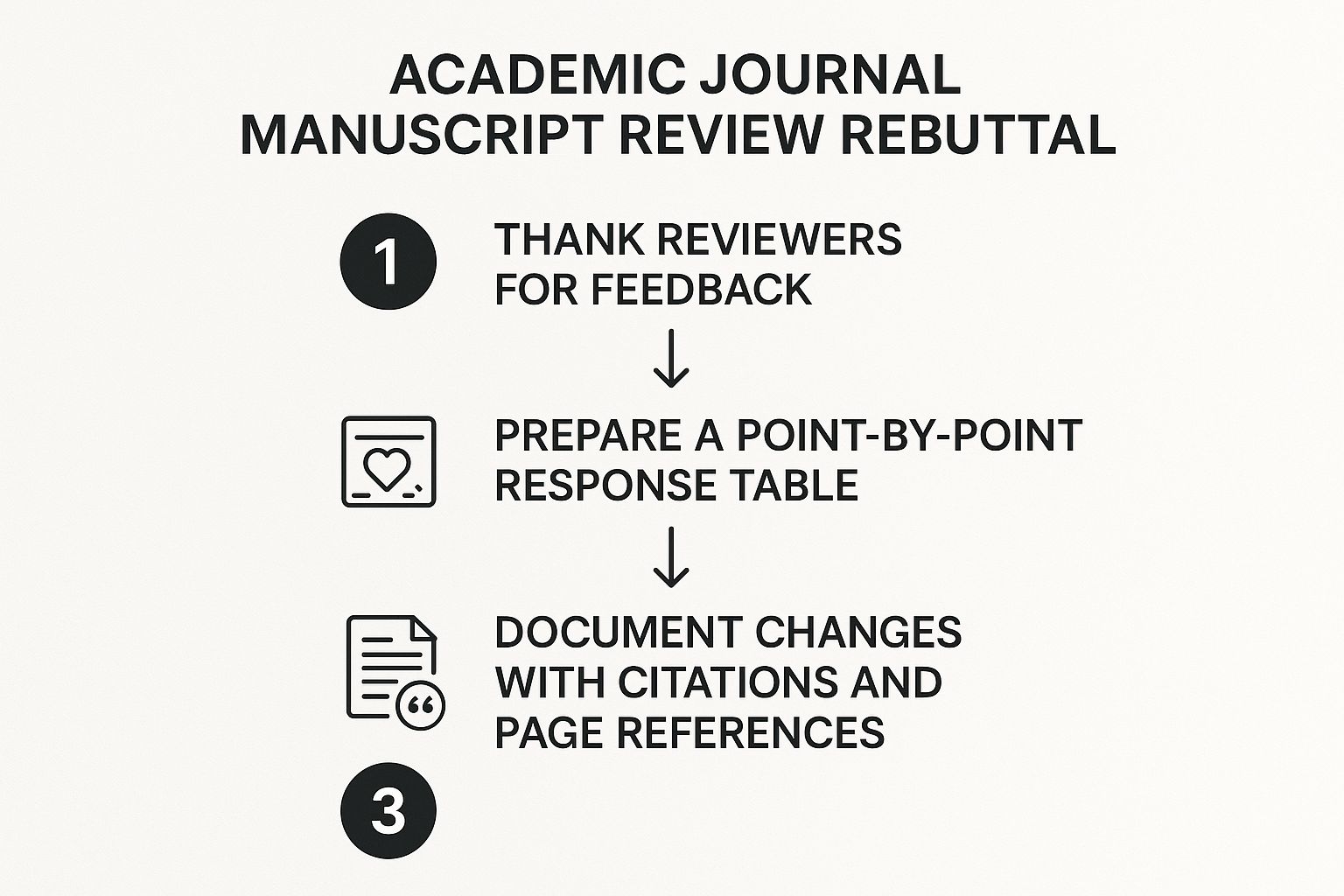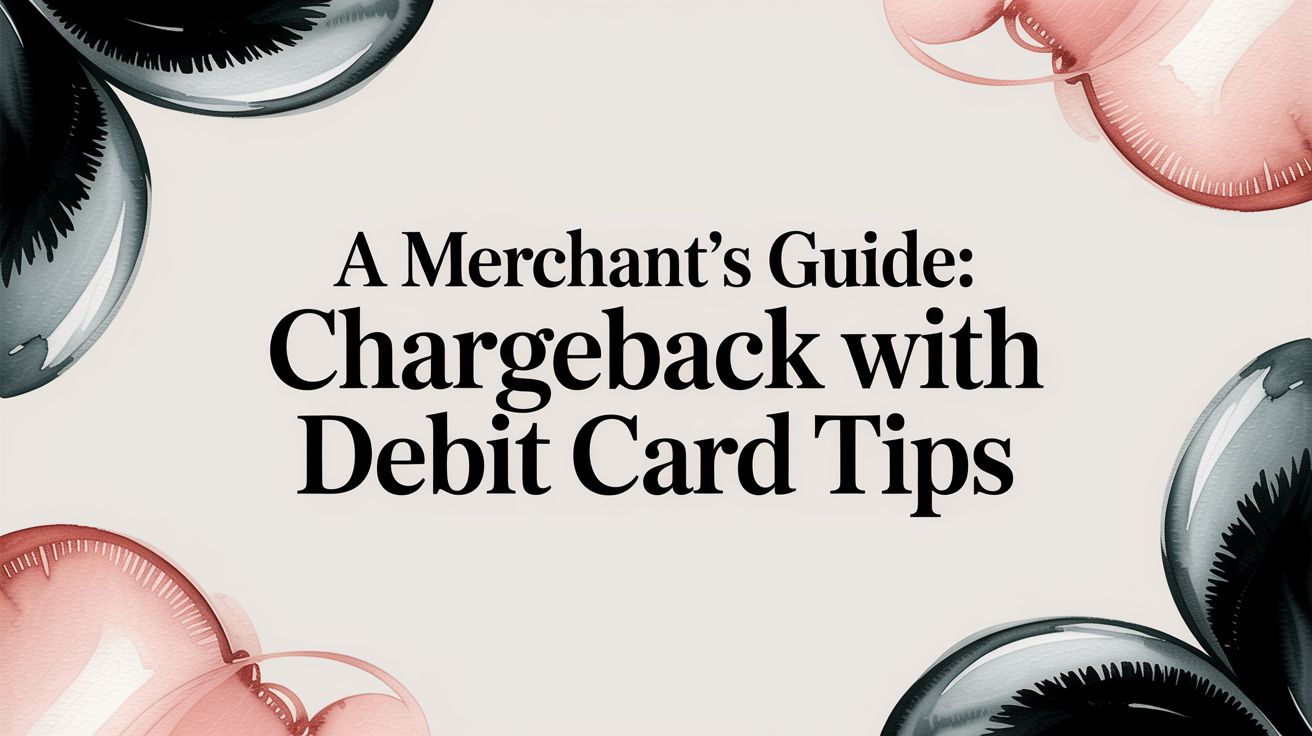
Getting a rejection, a negative review, or a denied claim is never easy. Whether it's from an insurance company, your boss, or a journal editor, the first reaction is often frustration. But a smart response can change the outcome. A well-written letter of rebuttal is your professional tool to challenge a decision, correct mistakes, and present your side of the story with clarity and confidence. It’s not about arguing; it's about being persuasive, factual, and strategic.
This guide gives you more than just basic templates. We'll look at six different situations, each with a complete letter of rebuttal sample you can adapt. For each example, we'll break down the specific tactics used, the tone, and the structure that makes it work. You'll learn how to organize your thoughts, present evidence, and keep a professional tone, even when you disagree.
Building a strong rebuttal in any situation requires solid evidence. A good first step is understanding what constitutes a credible source to make sure your arguments are built on a strong, verifiable foundation. From disputing a performance review to appealing a denied insurance claim, we’ll give you practical strategies to make your case and get the results you want. Let's get started.
1. Academic Journal Manuscript Review Rebuttal
An academic journal manuscript review rebuttal is a formal letter that researchers send to journal editors. It's a direct response to the comments, criticisms, and suggestions made by peer reviewers who have checked out a submitted research paper. This letter is a key part of the scholarly publishing process, giving authors a chance to clarify their work, explain changes, and respectfully defend their research choices.
A strong rebuttal letter can be the difference between getting a manuscript accepted for publication or being rejected. It shows the editor that you've carefully considered the feedback and are committed to improving your paper.
When and Why to Use This Approach
You'll use this type of rebuttal letter after your manuscript has been peer-reviewed and the journal editor sends you a decision of "revise and resubmit." This is a good sign, meaning the journal is interested in your work but wants improvements based on reviewer feedback.
The main goals are to:
- Show you're responsive: Let the editor and reviewers know you took their feedback seriously.
- Strengthen your manuscript: Use the comments to improve your paper's clarity, methods, and impact.
- Persuade the editor: Convince the editor that the revised manuscript is now ready for publication.
A well-organized rebuttal addresses every point raised, making it easy for the editor to see how you have improved the paper. A great letter of rebuttal sample will always show this organized, point-by-point structure.
Crafting Your Rebuttal: A Step-by-Step Flow
To write an effective academic rebuttal, follow a clear, organized process. This ensures you address all reviewer comments thoroughly and professionally, increasing your chances of acceptance.
This infographic outlines the three core steps for structuring your response.

The flow from appreciation to detailed, documented responses provides a logical and persuasive structure that editors and reviewers can easily follow.
Actionable Tips for Success
- Start with Gratitude: Always begin by thanking the editor and reviewers for their time and helpful comments.
- Use a Table: Organize your responses in a three-column table: (1) Reviewer Comment, (2) Your Response, and (3) Action Taken.
- Be Specific: When describing changes, mention the exact page, paragraph, and line numbers in the revised manuscript (e.g., "We have revised this section on page 5, lines 112-115.").
- Stay Professional: Never be defensive or dismissive. Acknowledge valid points and politely explain your position if you disagree, providing evidence or citations to support your argument.
To see how these ideas work in different settings, you can find more information about a compelling example of a rebuttal letter online.
2. Insurance Claim Denial Rebuttal Letter
An insurance claim denial rebuttal letter is a formal appeal that policyholders send to an insurance company. This letter challenges a decision to deny, reduce, or underpay an insurance claim. It acts as a structured argument to correct misunderstandings, present new evidence, and explain why the original decision was wrong based on the policy's terms.

This document is a critical tool for consumers to stand up for their rights. A well-written rebuttal can overturn an unfavorable decision, getting you the benefits you're owed. This could mean getting a $50,000 surgery approved, receiving the full replacement cost for home damages, or winning disability benefits after an initial denial.
When and Why to Use This Approach
You should use this type of rebuttal right after getting a denial or an unsatisfactory settlement offer from your insurer. Most policies have a strict deadline for appeals, often from 30 to 180 days, so acting quickly is important.
The main goals of this letter are to:
- Formally dispute the decision: Create an official record of your disagreement with the insurer's findings.
- Present a compelling case: Use facts, policy language, and supporting documents to build a strong argument for approval.
- Force a re-evaluation: Make the insurance company conduct a new, more thorough review of your claim.
A clear, evidence-based rebuttal letter shows that you are serious about pursuing your claim and are ready to defend your position. Every letter of rebuttal sample you find for insurance claims will stress the importance of a structured, factual approach.
Crafting Your Rebuttal: A Step-by-Step Flow
To write an effective insurance rebuttal, you need a methodical process. This makes sure your argument is clear, professional, and backed by solid evidence, which greatly improves your chances of a successful appeal.
The flow involves starting with a clear statement of purpose, methodically presenting your arguments with supporting evidence, and finishing with a specific request for action. This logical progression makes it easy for the claims adjuster to follow your reasoning and reconsider their initial decision.
Actionable Tips for Success
- Reference Specific Policy Language: Quote the exact sections of your insurance policy that support your claim. This changes the argument from opinion to a contractual obligation.
- Include All Supporting Documents: Attach and label all relevant documents, such as medical records, expert reports, police reports, or contractor estimates.
- Send via Certified Mail: Mail your letter via certified mail with a return receipt requested. This provides legal proof that the insurance company received your appeal.
- Be Professional and Factual: Avoid emotional language. Stick to the facts of the case, present your evidence clearly, and maintain a firm but respectful tone throughout the letter.
Handling disputes with large companies requires a strategic approach, a principle that also applies when you need to how to win a credit card dispute on chargepay.ai.
3. Employee Performance Evaluation Rebuttal
An employee performance evaluation rebuttal is a formal document an employee writes to dispute information in their performance review. It's a direct response to what you see as inaccuracies, unfair assessments, or negative comments made by a manager. This letter gives you an official way to present your side of the story, correct the record, and protect your professional reputation.
This document becomes part of an employee's permanent personnel file. A well-written rebuttal can be crucial for contesting disciplinary actions or providing necessary context if legal issues come up later. It shows professionalism and a commitment to a fair evaluation.

When and Why to Use This Approach
You should use this type of rebuttal letter when you get a performance evaluation that you believe has factual errors, biased assessments, or lacks important context. It’s your official opportunity to make sure your personnel file shows a complete and accurate picture of your performance.
The main goals are to:
- Correct the Record: Formally document and fix any factual inaccuracies or misleading statements in your review.
- Provide Context: Explain circumstances that may have affected your performance which your manager overlooked.
- Protect Your Career: Create a formal record of your disagreement, which can be vital for future promotions, references, or legal disputes.
A strong rebuttal focuses on facts and evidence, not feelings. It shows that you are engaged and proactive about your professional standing, turning a negative review into a documented conversation. For anyone in a customer-facing role, knowing how to manage feedback is key, much like you can learn more about how to handle customer complaints to improve service.
Crafting Your Rebuttal: A Step-by-Step Flow
To write an effective performance review rebuttal, approach it with a calm, organized, and fact-based strategy. This method ensures your response is professional, credible, and deals with the key issues without creating an emotional conflict.
- Acknowledge and State Purpose: Begin by calmly acknowledging you received the evaluation and clearly state that your letter is a formal rebuttal to specific points.
- Address Points with Evidence: Systematically go through each point you disagree with. For each one, state the inaccuracy and then provide solid evidence to support your position, such as sales data, project reports, or positive emails from colleagues and clients.
- Propose a Resolution: Finish by asking for a specific action. This could be asking for a follow-up meeting, requesting that your rebuttal be attached to the official review, or suggesting different wording for the evaluation.
This logical progression from acknowledgment to evidence-based correction and a clear call to action provides a powerful and professional framework.
Actionable Tips for Success
- Be Timely and Professional: Stick to any deadlines for submitting a rebuttal outlined in your employee handbook. Keep a respectful and objective tone throughout.
- Focus on Facts, Not Feelings: Avoid emotional language. Instead of saying "I feel this is unfair," state "The review claims I missed my sales target, but the attached report shows I exceeded it by 15%."
- Provide Documentation: Attach copies of any evidence that supports your claims, such as emails, sales figures, project plans, or witness statements.
- Acknowledge Valid Points: If some criticisms are fair, briefly acknowledge them and state your commitment to improvement. This makes the points you are contesting more believable.
4. Grant Proposal Rejection Rebuttal
A grant proposal rejection rebuttal is a formal letter sent to a funding organization, such as a foundation or government agency, after a grant application has been turned down. This letter aims to persuade the funder to reconsider their decision by addressing reviewer feedback, clarifying points of confusion, or providing new, compelling information.
While not all funders accept rebuttals, a well-written one can be a powerful tool. It shows your commitment to the project and your ability to respond constructively to criticism, potentially turning a rejection into a funding opportunity.
When and Why to Use This Approach
You'll use this type of rebuttal only when a funder's guidelines specifically allow for appeals or reconsiderations. It's most effective when the reviewers' critiques are based on misunderstandings of your proposal or when you have new data that directly addresses their main concerns.
The main goals are to:
- Correct misunderstandings: Clear up any confusion the reviewers had about your project's methodology, goals, or impact.
- Strengthen your case: Introduce new evidence or a revised plan that directly fixes the weaknesses identified in the review.
- Show resilience: Let the funding agency know that you are a serious, adaptable, and dedicated applicant.
A successful rebuttal provides a clear, evidence-based argument that makes it easy for the program officer to argue for a second look at your proposal. Every strong letter of rebuttal sample for a grant will highlight this persuasive, solution-focused approach.
Crafting Your Rebuttal: A Step-by-Step Flow
To write an effective grant rebuttal, you must be strategic, respectful, and evidence-driven. This process helps you build a compelling case for reconsideration without seeming argumentative.
A respectful tone combined with a focus on substantive, actionable changes is key. Your goal is to show how you've turned the reviewers' concerns into strengths in your revised project plan.
Actionable Tips for Success
- Confirm the Process: Before you write anything, check that the funder accepts rebuttals. Sending an unsolicited one can backfire.
- Focus on Substance: Address the major, important criticisms, such as concerns about methodology or feasibility. Don't waste space on minor stylistic points.
- Provide New Evidence: Strengthen your argument with new data, letters of support, or pilot results that were not in your original application.
- Be Gracious and Professional: Begin by thanking the reviewers for their time and insightful feedback. Keep a respectful tone throughout, even if you disagree with a point.
- Keep it Concise: Limit your rebuttal to just a few pages. Focus on the most critical points that could change the decision.
By following a structured and professional process, you can greatly improve your chances of having a decision overturned. For more guidance on structuring your document, you can find helpful tips by exploring the topic of a rebuttal letter format online.
5. Credit Report Dispute Letter (Credit Bureau Rebuttal)
A credit report dispute letter is a formal statement you send to credit reporting agencies like Equifax, Experian, or TransUnion. It's used to challenge inaccurate, incomplete, or unverifiable information on your credit report. This letter officially starts a process where the credit bureau must investigate your claim, usually within 30 days.
This type of rebuttal is a powerful tool for protecting your financial health. If the information you dispute can't be verified by the creditor, the credit bureau is legally required to correct or remove it. A successful dispute can lead to a significant jump in your credit score.
When and Why to Use This Approach
You should use this rebuttal letter whenever you find an error on your credit report. These mistakes can range from fraudulent accounts opened by identity thieves to simple clerical errors like wrong payment statuses or paid-off debts still showing a balance.
The main goals are to:
- Correct inaccuracies: Make sure your credit history is a true reflection of your financial behavior.
- Protect your score: Remove negative items that are unfairly lowering your credit score.
- Prevent financial harm: A clean credit report is essential for getting approved for loans, credit cards, and even housing or employment.
A well-written dispute letter clearly identifies the error, explains why it is wrong, and provides evidence to back up your claim. This makes it easier for the credit bureau to process your request and rule in your favor.
Crafting Your Rebuttal: A Step-by-Step Flow
To write a successful credit dispute letter, you need to be clear, factual, and direct. The process involves gathering evidence and presenting your case in a way that leaves no room for confusion, forcing the credit bureau to take action.
This infographic outlines the three core steps for structuring your dispute.
This simple flow from identification to proof and formal request provides a clear, documented case that the credit bureaus are required to investigate.
Actionable Tips for Success
- Be Specific: Clearly identify the account number and the exact information you are disputing. Explain precisely why it is incorrect.
- Include Proof: Send copies (never originals) of supporting documents like bank statements, payment receipts, or police reports for identity theft.
- Send Certified: Mail your letter via certified mail with a return receipt requested. This provides proof that the credit bureau received it.
- Dispute with All Three: Credit bureaus don't share information, so if the error appears on all three of your reports, you must send a separate dispute letter to each one.
To get started, you can explore various rebuttal letter templates that cover different scenarios. You can learn more about a credit report dispute letter template on ChargePay.ai to see how these tips are applied.
6. Trademark or Patent Office Action Rebuttal
A trademark or patent office action rebuttal is a formal legal response sent to a government body like the U.S. Patent and Trademark Office (USPTO). This letter is written when an examiner raises objections or refuses an application for a patent or trademark. It is a highly specialized document that presents legal arguments, evidence, and application changes to overcome the examiner's concerns.
This type of rebuttal is essential for protecting intellectual property. A well-argued response can mean the difference between securing exclusive rights to an invention or brand name and having the application dropped. It is the applicant's chance to directly address legal and technical rejections and persuade the examiner to grant the registration.
When and Why to Use This Approach
You must use this type of rebuttal after receiving an "Office Action" from a patent or trademark office. This official message details why your application can't be approved as it is. It is not an outright rejection but an invitation to solve specific issues.
The main goals are to:
- Overcome Legal Objections: Directly address the examiner's rejections, whether they relate to a trademark's uniqueness or a patent's novelty.
- Provide Clarification and Evidence: Submit new evidence, change claims, or present legal arguments to support your application's validity.
- Advance the Application: Convince the examiner that all issues have been resolved, moving your application forward to registration or allowance.
A carefully prepared rebuttal shows the examiner you have a strong legal basis for your application and have addressed their concerns in good faith. A good letter of rebuttal sample for an office action will highlight this structured, evidence-based approach.
Actionable Tips for Success
- Engage an IP Attorney: These are complex legal documents. Work with an experienced intellectual property attorney right after receiving an office action.
- Analyze the Rejection: Carefully review the examiner's reasoning and all cited references or "prior art" to fully understand why it was rejected.
- Argue or Amend: Strategically decide whether to argue against the examiner's points, amend your application to overcome them, or use a mix of both tactics.
- Provide Concrete Evidence: Support your arguments with solid evidence. For trademarks, this could be proof of use in commerce; for patents, it could be technical data that sets your invention apart.
- Meet All Deadlines: Office actions have strict, non-negotiable deadlines. Missing one can result in your entire application being abandoned.
- Maintain a Professional Tone: Your response must be respectful and professional, even when you strongly disagree with the examiner's position.
Letter of Rebuttal Types Comparison
Turning Disagreements into Wins
Writing a rebuttal letter can feel like a big challenge, but as we've seen, it's really just a structured conversation on paper. The main lesson from every letter of rebuttal sample we looked at is that a calm, organized, and evidence-backed response is your most powerful tool. Whether you're challenging a performance review, an insurance denial, or a manuscript rejection, the basic principles are the same.
The goal isn't just to argue; it's to persuade. This change in mindset is what separates a complaint from a successful rebuttal. Instead of reacting emotionally, you're building a logical case designed to lead the other person to the conclusion you want.
Your Rebuttal Blueprint: Key Takeaways
Let's boil down the most important strategies from our examples into a simple, actionable checklist. Think of this as your go-to guide before you start writing:
- Lead with Logic, Not Emotion: Your strongest points are always factual. Start by gathering every piece of supporting evidence: emails, reports, policy documents, or data. This is the foundation of your argument.
- Structure is Your Friend: A disorganized letter confuses the reader and weakens your case. Follow a clear format: acknowledge the initial decision, present your counter-arguments with evidence for each, and state what you want to happen.
- Maintain a Professional Tone: Courtesy is a strategic advantage. A respectful and professional tone makes the recipient more open to your point of view, even when you are directly disagreeing with their conclusion.
- Focus on the “Why”: Don’t just say that a decision was wrong. Clearly explain why it was wrong, referencing specific facts, policies, or overlooked information. This turns your letter from a simple dispute into a compelling argument.
From Theory to Action: Your Next Steps
You now have the templates and the strategic insights to build a powerful rebuttal. The next time you face a decision you need to challenge, don't just get frustrated. See it as a chance to use these skills.
Start by figuring out which letter of rebuttal sample from our list most closely matches your situation. Use its structure as your starting point, but remember to customize every detail to fit your specific circumstances. The techniques we've covered are more than just letter-writing tactics; they are fundamental skills in negotiation and communication. To really turn disagreements into successful outcomes, it helps to understand broader strategies for winning a debate, which often involve strong rebuttal techniques.
Ultimately, mastering the art of the rebuttal letter is about empowerment. It gives you a formal, effective way to advocate for yourself, correct inaccuracies, and achieve fair outcomes. You are no longer just a passive recipient of a decision; you are an active participant in the resolution.
For e-commerce merchants constantly battling chargebacks, writing rebuttal letters is a drain on time and resources. ChargePay automates this entire process, using AI to generate and submit evidence-based chargeback rebuttals for you. Stop losing revenue to friendly fraud and let ChargePay turn those disputes into wins.







.svg)







.svg)
.svg)
.svg)